Characterization of Narrowband Noise and Channel Capacity for Powerline Communication in France
Abstract
:1. Introduction
- (1)
- The first one consists in analyzing the noise characteristics in time-frequency representation, the transfer functions measured in five different sites (i.e., urban, rural, sub rural, urban dense 1, and urban dense 2) in several LV networks in France. This activity is conducted in partnership with Enedis. The analysis of the noise profiles is of utmost importance to develop robust techniques to improve the communication between the smart meter and the data concentrator, and the data rate, latency, reliability and security.
- (2)
- The second one consists in estimating the channel capacity in various LV sites. This study has a major interest, particularly to support new IoT dedicated to smart grids’ applications and services.
2. Experimental Measurement Setup and Methods
2.1. Identification of Measurement Sites
- Rural site: the rated power of the transformer equals 250 kVA can supply 89 customer installations. The transformer and the smart electricity meter are connected using a 200-m long underground cable and a 164 m twisted overhead connection cable. One producer is connected to the network.
- Sub rural site: the rated power of the transformer equals 400 kVA. It supplies 142 customers. The transformer and the smart electricity meter are connected through a 220-m long underground cable. No producer is connected to the network.
- Urban site: it represents a residential site. The rated power of the transformer equals 250 kVA. It supplies 250 customers. The transformer and the smart electricity meter are connected using a 335 m of 150 mm2 aluminum underground cable, and a 10 m twisted overhead connection cable with a 4 × 35 mm2 section. No producer is connected to the network.
- Urban dense 1 site: the transformer is directly integrated in a building. Its rated power equals 400 kVA. It can supply 65 customers. The transformer and the smart electricity meter are connected through a 115 m aluminum underground cable. No producer is connected to the network.
- Urban dense 2 site: It does not have the same features as the urban dense 1. The transformer is also implemented in a building, but its rated power equals 650 kVA. It can supply 359 customers. The transformer and the smart electricity meter are connected through a 62-m long aluminum underground cable. No producer is connected to the network.
2.2. Experimental Procedure
- Colored background noise corresponds to the superposition of several low signals that are present in the channel. This type of noise has a low decreasing PSD in the frequency domain. The dependence of the frequency-colored noise is very clear at low frequency, and its PSD is practically constant at high frequency.
- Narrowband noise is composed of sinusoids coupled with the grid by either broadcast signals or electrical devices. Broadcast signals are typically amplitude-modulated sinusoids.
- Periodic impulsive noise asynchronous to the mains is identified as an impulse train in the frequency band from 50 to 200 kHz. It is generated by the switched-mode power supplies.
- Periodic impulsive noise synchronous to the mains is caused by high power switching of semiconductor devices.
- Aperiodic impulsive noise is composed of impulses of short duration and high amplitude caused by switching transients.
2.2.1. Measurement of Noise Power Spectrum in the Transformer Substation
2.2.2. Temporal Measurement Setup
2.2.3. Measurement Scenarios
2.2.4. Measurement Protocol of the Transfer Function
- Y(f)VNA-RX is the received signal.
- X(f)VNA-TX is the injected signal.
3. Main Experimental Results and Discussion
3.1. Noise Power Spectral Density Analysis at a Specific Time
3.2. Noise Power Spectral Density Evolution at Different Times of the Day
3.3. Noise Cyclostationary Behavior
3.3.1. Summary of the Results for the Sub Rural Site
3.3.2. Summary of the Results for the Rural Site
3.3.3. Summary of the Results for the Urban Site
3.3.4. Summary of the Results for the Urban Dense 1 Site
3.4. Transfer Function Analysis and Signal-to-Noise Ratio
- Pe: emitted power of the signal. This parameter is set to 120 dBµV.
- f: frequency.
- |H(f)|: transfer function modulus.
- Pn: noise power measured at 10 a.m.
3.5. Estimation of the Channel Capacity
- SNR: signal-to-noise ratio.
- N: number of carriers.
- : frequency band of one carrier.
3.5.1. Estimation of the Channel Capacity in the CENELEC A Band
3.5.2. Estimation of the Channel Capacity in the FCC Band
3.5.3. Summary of the Results
4. Discussion
5. Conclusions
Author Contributions
Funding
Acknowledgments
Conflicts of Interest
References
- Saleem, Y.; Member, S.; Crespi, N.; Member, S.; Husain Rehmani, M.; Copeland, R. Internet of Things-Aided Smart Grid: Technologies, Architectures, Applications, Prototypes, and Future Research Directions. arXiv, 2017; arXiv:1704.08977. [Google Scholar]
- Karnouskos, S. The cooperative Internet of Things enabled Smart Grid. In Proceedings of the 14th IEEE International Symposium on Consumer Electronics (ISCE2010), Braunschweig, Germany, 7–10 June 2010. [Google Scholar]
- O’Neill, S. Generalized Hyperalgesia in Chronic Low-Back Pain; River Publishers: Gistrup, Denmark, 2013; ISBN 8792329675. [Google Scholar]
- Pereira, S.C.; Caporali, A.S.; Casella, I.R.S. Power line communication technology in industrial networks. In Proceedings of the 2015 IEEE International Symposium on Power Line Communications and Its Applications (ISPLC), Austin, TX, USA, 29 March–1 April 2015; pp. 216–221. [Google Scholar]
- IEEE 802.11p Performance for Vehicle-To-Anything Connectivity in Urban Interference Channels. Available online: https://www.researchgate.net/publication/324729630_IEEE_80211p_Performance_for_Vehicle-to-Anything_Connectivity_in_Urban_Interference_Channels (accessed on 5 October 2018).
- Oliveira, R.M.; Vieira, A.B.; Latchman, H.A.; Ribeiro, M.V. Medium Access Control Protocols for Power Line Communication: A Survey. IEEE Commun. Surv. Tutor. 2018. [Google Scholar] [CrossRef]
- Salvadori, F.; Gehrke, C.S.; de Oliveira, A.C.; de Campos, M.; Sausen, P.S. Smart Grid Infrastructure Using a Hybrid Network Architecture. IEEE Trans. Smart Grid 2013, 4, 1630–1639. [Google Scholar] [CrossRef]
- Oliveira, T.R.; Picorone, A.A.M.; Zeller, C.B.; Netto, S.L.; Ribeiro, M.V. On the statistical characterization of hybrid PLC-wireless channels. Electr. Power Syst. Res. 2018, 163, 329–337. [Google Scholar] [CrossRef]
- Zhang, J.; Hasandka, A.; Wei, J.; Alam, S.; Elgindy, T.; Florita, A.; Hodge, B.-M.; Zhang, J.; Hasandka, A.; Wei, J.; et al. Hybrid Communication Architectures for Distributed Smart Grid Applications. Energies 2018, 11, 871. [Google Scholar] [CrossRef]
- Usman, A.; Shami, S.H. Evolution of Communication Technologies for Smart Grid applications. Renew. Sustain. Energy Rev. 2013, 19, 191–199. [Google Scholar] [CrossRef]
- Razazian, K.; Umari, M.; Kamalizad, A.; Loginov, V.; Navid, M. G3-PLC specification for powerline communication: Overview, system simulation and field trial results. In Proceedings of the ISPLC2010, Rio de Janeiro, Brazil, 28–31 March 2010; pp. 313–318. [Google Scholar]
- Signalling on Low-Voltage Electrical Installations in the Frequency Range 3 kHz to 148.5 kHz. General Requirements, Frequency Bands and Electromagnetic Disturbances—BSI British Standards. Available online: https://shop.bsigroup.com/ProductDetail/?pid=000000000030202784 (accessed on 5 October 2018).
- Lin, J.; Nassar, M.; Evans, B.L. Impulsive Noise Mitigation in Powerline Communications Using Sparse Bayesian Learning. arXiv, 2013; arXiv:1303.1217. [Google Scholar] [CrossRef]
- Nassar, M.; Lin, J.; Mortazavi, Y.; Dabak, A.; Kim, H.I.; Evans, B.L. Local Utility Powerline Communications in the 3–500 kHz Band: Channel Impairments, Noise, and Standards. IEEE Signal Proc. Mag. 2012, 29, 116–127. [Google Scholar] [CrossRef]
- Sendin, A.; Simon, J.; Urrutia, I.; Berganza, I. PLC deployment and architecture for Smart Grid applications in Iberdrola. In Proceedings of the 18th IEEE International Symposium on Power Line Communications and Its Applications, Glasgow, UK, 30 March–2 April 2014; pp. 173–178. [Google Scholar]
- G3-PLC Alliance Home. Available online: http://www.g3-plc.com/home/ (accessed on 05 October 2018).
- Oksman, V.; Zhang, J.G. HNEM: The new ITU-T standard on narrowband PLC technology. IEEE Commun. Mag. 2011, 49, 36–44. [Google Scholar] [CrossRef]
- Cataliotti, A.; Daidone, A.; Tine, G. Power Line Communication in Medium Voltage Systems: Characterization of MV Cables. IEEE Trans. Power Deliv. 2008, 23, 1896–1902. [Google Scholar] [CrossRef]
- Papadopoulos, T.A.; Chrysochos, A.I.; Papagiannis, G.K. Narrowband power line communication: Medium voltage cable modeling and laboratory experimental results. Electr. Power Syst. Res. 2013, 102, 50–60. [Google Scholar] [CrossRef]
- Artale, G.; Cataliotti, A.; Cosentino, V.; Di Cara, D.; Fiorelli, R.; Guaiana, S.; Tine, G. A New Low Cost Coupling System for Power Line Communication on Medium Voltage Smart Grids. IEEE Trans. Smart Grid 2018, 9, 3321–3329. [Google Scholar] [CrossRef]
- Xie, Z.; Dong, F.; Luo, L.; Deng, S.; Cao, W. Research on channel noise of the MV power line considering the LV feedback noise. In Proceedings of the 4th International Conference on Power Engineering, Energy and Electrical Drives, Istanbul, Turkey, 13–17 May 2013; pp. 1648–1651. [Google Scholar]
- Elfeki, I.; Doligez, T.; Aouichak, I.; Le Bunetel, J.-C.; Raingeaud, Y. Estimation of PLC transmission line and crosstalk for LV outdoor electrical cables. In Proceedings of the 2017 International Symposium on Electromagnetic Compatibility—EMC EUROPE, Angers, France, 4–7 September 2017; pp. 1–6. [Google Scholar]
- Kaiser, C.; Otterbach, N.; Dostert, K. Spectral correlation analysis of narrowband power line noise. In Proceedings of the 2017 IEEE International Symposium on Power Line Communications and its Applications (ISPLC), Madrid, Spain, 3–5 April 2017; pp. 1–6. [Google Scholar]
- Nieman, K.F.; Lin, J.; Nassar, M.; Waheed, K.; Evans, B.L. Cyclic spectral analysis of power line noise in the 3–200 kHz band. In Proceedings of the 2013 IEEE 17th International Symposium on Power Line Communications and Its Applications, Johannesburg, South Africa, 24–27 March 2013; pp. 315–320. [Google Scholar]
- Milioudis, A.N.; Syranidis, K.N.; Andreou, G.T.; Labridis, D.P. Modeling of Medium-Voltage Power-Line Communication Systems Noise Levels. IEEE Trans. Power Deliv. 2013, 28, 2004–2013. [Google Scholar] [CrossRef]
- Zajc, M.; Suljanovic, N.; Mujcic, A.; Tasic, J. Frequency Characteristics Measurement of Overhead High-Voltage Power-Line in Low Radio-Frequency Range. IEEE Trans. Power Deliv. 2007, 22, 2142–2149. [Google Scholar] [CrossRef]
- Sheikh, A.A.; Idrees, Q.; Ahmad, M.; Arshad, M.A.; Mahmood, I.; Fayyaz, U.U.; Rana, I.E.; Zaffar, N.A. Feasibility of NB-PLC in LT power distribution network of electric utility in Pakistan. In Proceedings of the 2016 Clemson University Power Systems Conference (PSC), Clemson, SC, USA, 8–11 March 2016; pp. 1–7. [Google Scholar]
- Zimmermann, M.; Dostert, K. A multipath model for the powerline channel. IEEE Trans. Commun. 2002, 50, 553–559. [Google Scholar] [CrossRef]
- Zimmermann, M.; Dostert, K. Analysis and modeling of impulsive noise in broad-band powerline communications. IEEE Trans. Electromagn. Compat. 2002, 44, 249–258. [Google Scholar] [CrossRef]
- Hallak, G.; Bumiller, G. Throughput optimization based on access impedance of PLC modems with limited power consumption. In Proceedings of the 2014 IEEE Global Communications Conference, Austin, TX, USA, 8–12 December 2014; pp. 2960–2965. [Google Scholar]
- Kruizinga, B.; Wouters, P.A.A.F.; Steennis, E.F. The effects of branches on condition related signals in Low Voltage underground power systems. In Proceedings of the 2014 IEEE Conference on Electrical Insulation and Dielectric Phenomena (CEIDP), Des Moines, IA, USA, 19–22 October 2014; pp. 578–581. [Google Scholar]
- Chu, G.; Li, J.; Liu, W. Narrow band power line channel characteristics for low voltage access network in China. In Proceedings of the 2013 IEEE 17th International Symposium on Power Line Communications and Its Applications, Johannesburg, South Africa, 24–27 March 2013; pp. 297–302. [Google Scholar]
- Liu, W.; Sigle, M.; Dostert, K. Channel characterization and system verification for narrowband power line communication in smart grid applications. IEEE Commun. Mag. 2011, 49, 28–35. [Google Scholar] [CrossRef]
- Bai, L.; Tucci, M.; Barmada, S.; Raugi, M.; Zheng, T.; Bai, L.; Tucci, M.; Barmada, S.; Raugi, M.; Zheng, T. Impulsive Noise Characterization in Narrowband Power Line Communication. Energies 2018, 11, 863. [Google Scholar] [CrossRef]
- Galli, S.; Scaglione, A.; Wang, Z. For the Grid and Through the Grid: The Role of Power Line Communications in the Smart Grid. Proc. IEEE 2011, 99, 998–1027. [Google Scholar] [CrossRef]
- Kim, I.H.; Kim, W.; Park, B.; Yoo, H. Channel measurements and field tests of narrowband power line communication over Korean underground LV power lines. In Proceedings of the 18th IEEE International Symposium on Power Line Communications and Its Applications, Glasgow, UK, 30 March–2 April 2014; pp. 132–137. [Google Scholar]
- Teixeira, E.A.; Marques, F.S.; de Araujo, S.G.; de Souza, E.M.; Johnson, T.M.; Ribeiro, M.V. Modeling and performance analysis of PLC channels with external interference in outdoor and indoor environments. In Proceedings of the 2008 IEEE International Symposium on Power Line Communications and Its Applications, Jeju City, Korea, 2–4 April 2008; pp. 222–227. [Google Scholar]
- Hooijen, O.G. On the channel capacity of the residential power circuit used as a digital communications medium. IEEE Commun. Lett. 1998, 2, 267–268. [Google Scholar] [CrossRef]
- Versolatto, F.; Tonello, A.M.; Tornelli, C.; Giustina, D. Della Statistical analysis of broadband underground medium voltage channels for PLC applications. In Proceedings of the 2014 IEEE International Conference on Smart Grid Communications (SmartGridComm), Venice, Italy, 3–6 November 2014; pp. 493–498. [Google Scholar]
- Rengaraju, P.; Lung, C.-H.; Srinivasan, A. Communication requirements and analysis of distribution networks using WiMAX technology for smart grids. In Proceedings of the 2012 8th International Wireless Communications and Mobile Computing Conference (IWCMC), Limassol, Cyprus, 27–31 August 2012; pp. 666–670. [Google Scholar]
- Borovina, D.; Mujcic, A.; Zajc, M.; Suljanovic, N. Investigation of Narrow-Band Power-Line Carrier Communication System Performance in Rural Distribution Grids. Elektronika Ir Elektrotechnika 2018, 24, 61–67. [Google Scholar] [CrossRef]
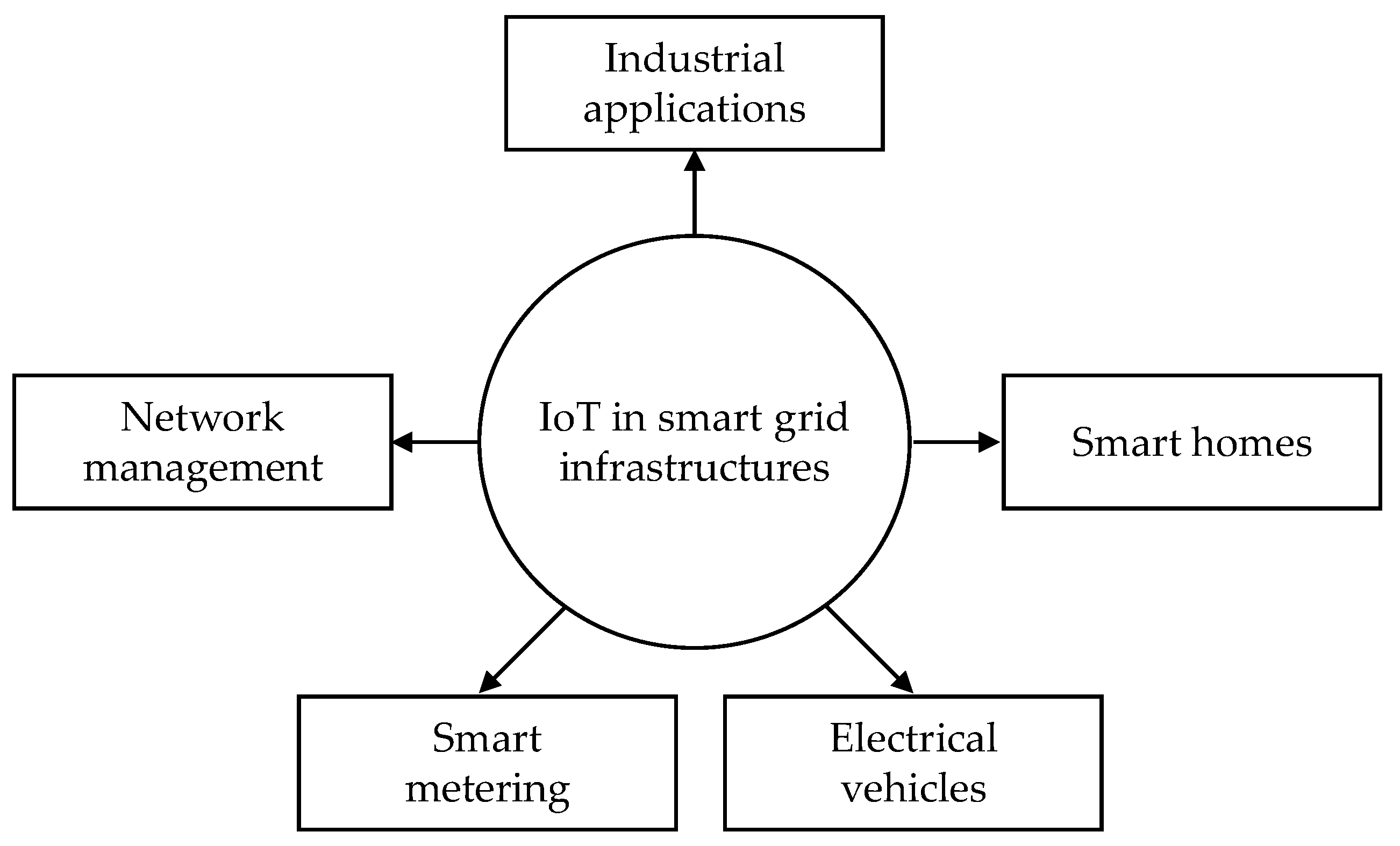
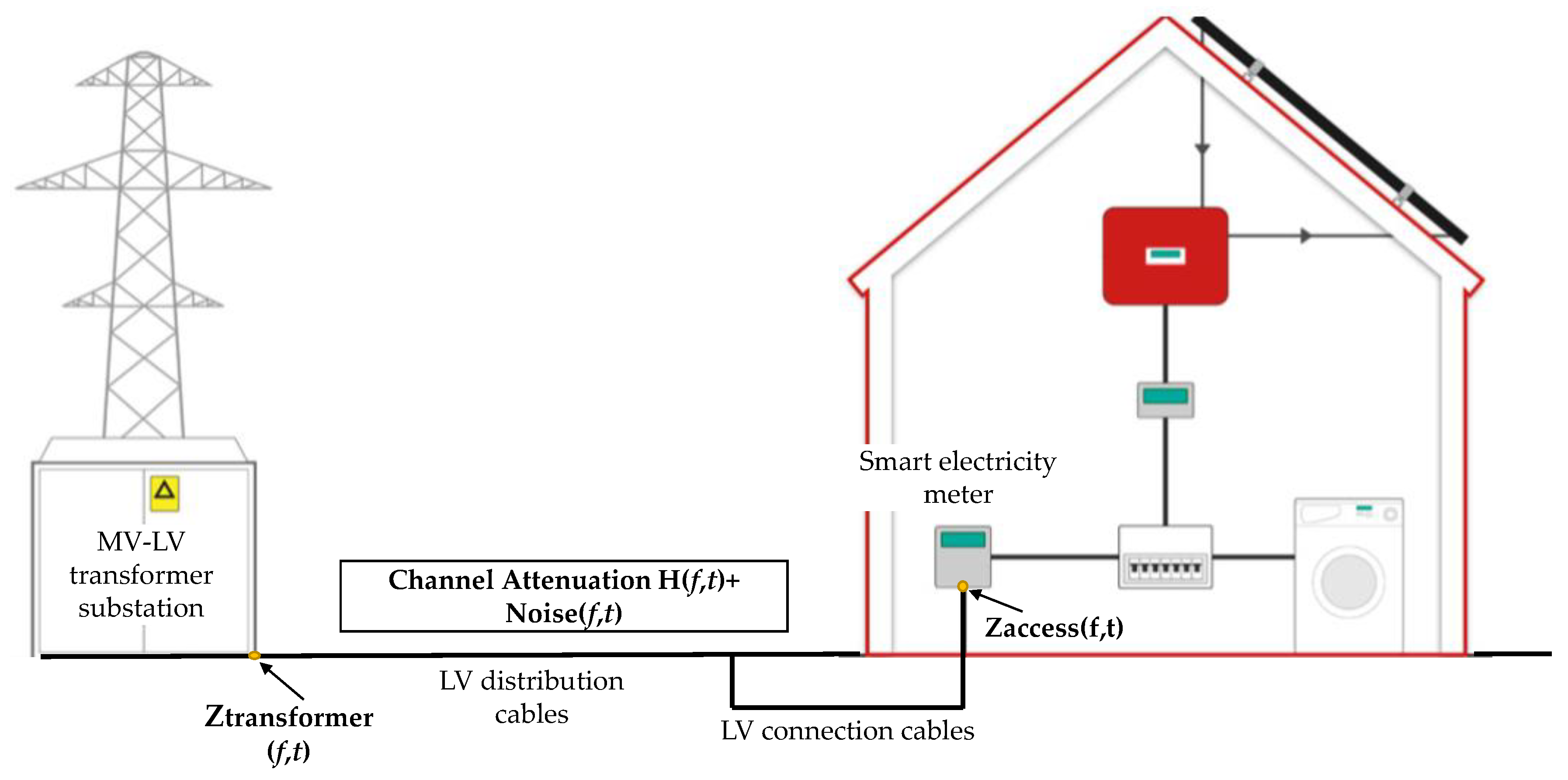
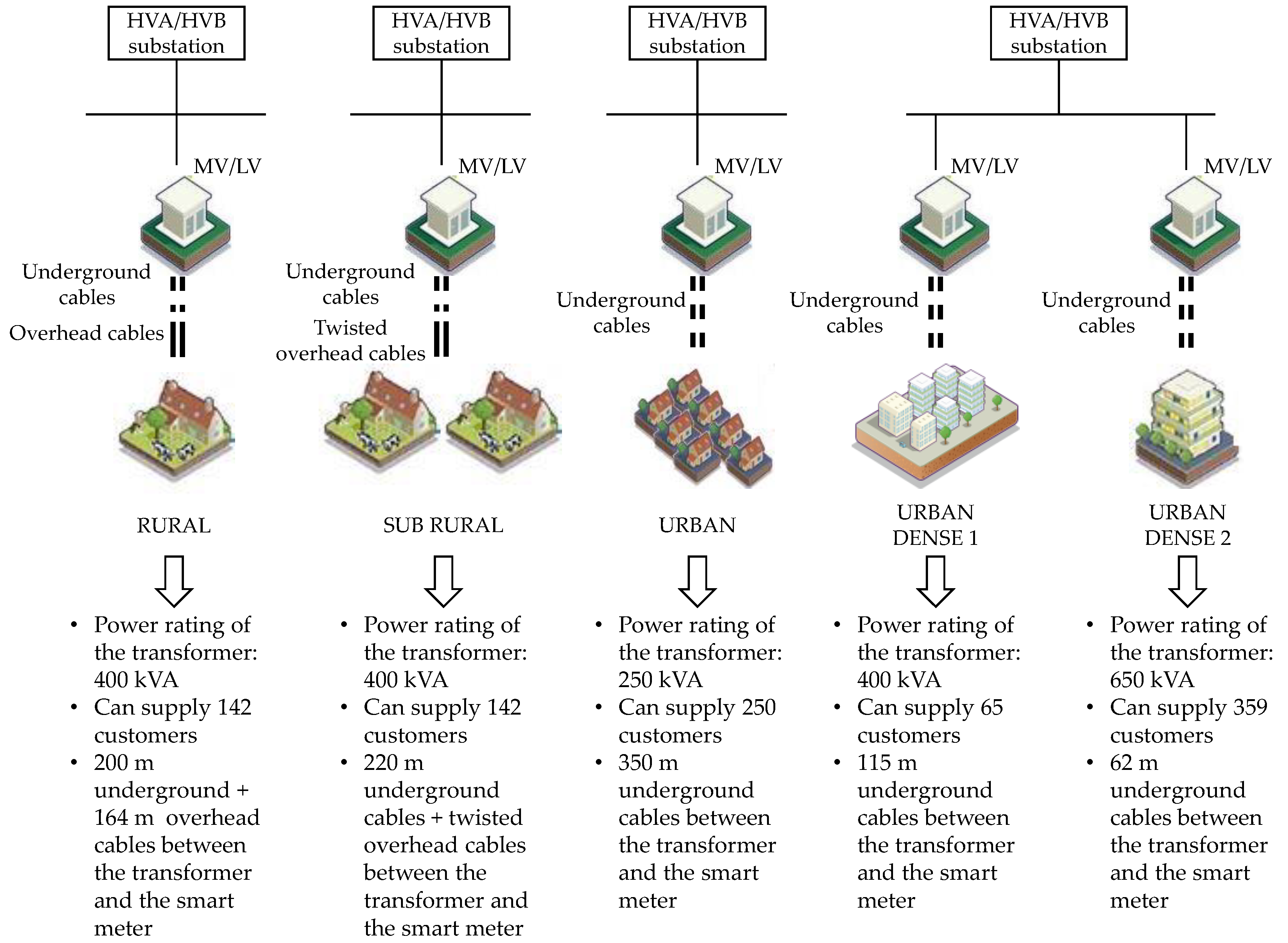

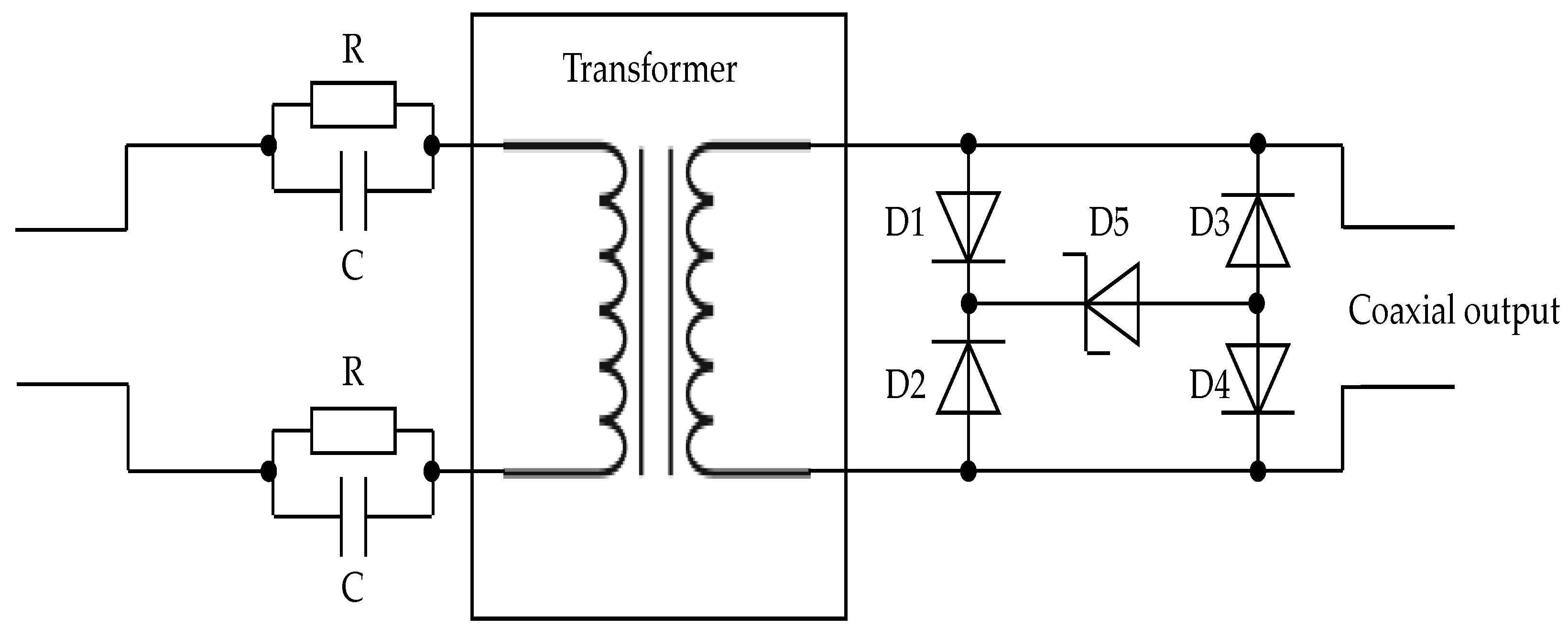
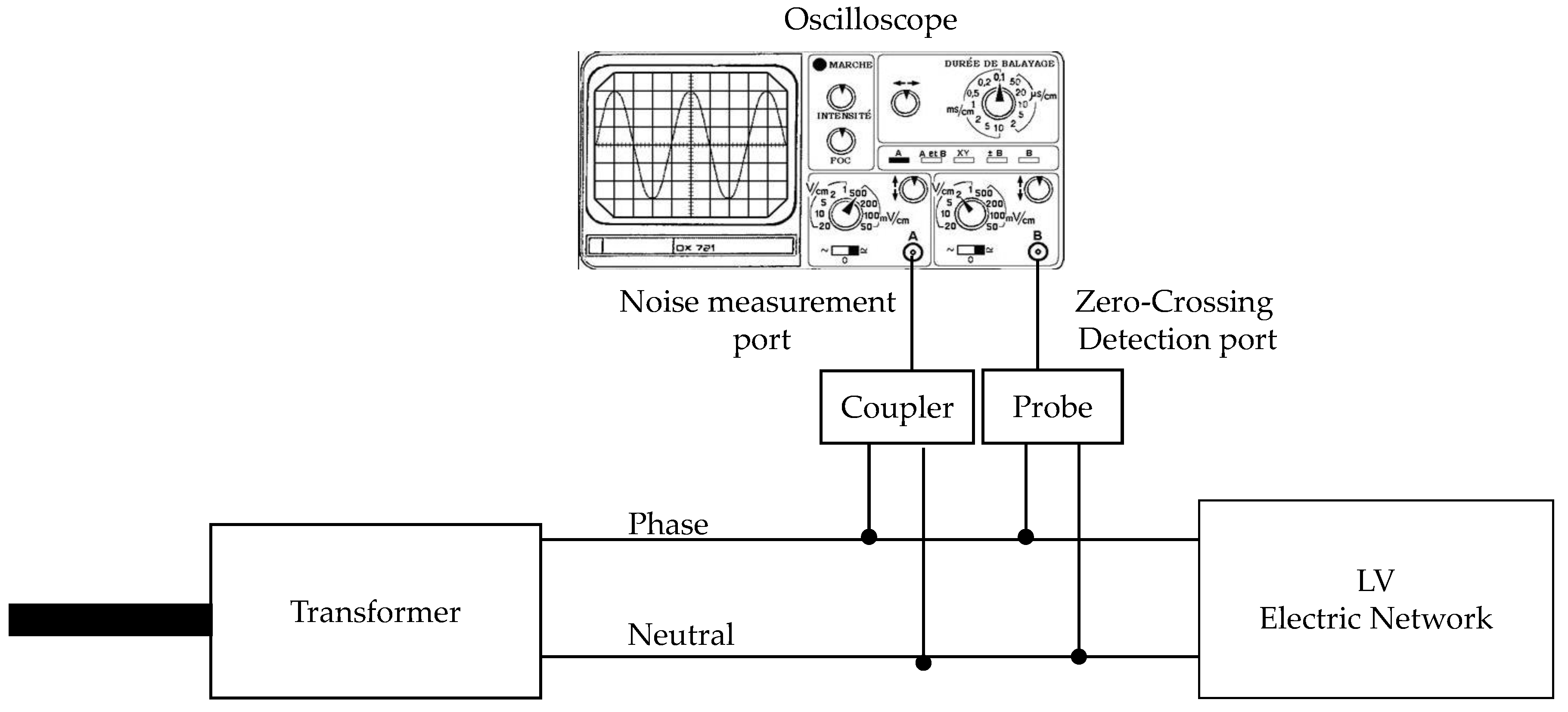
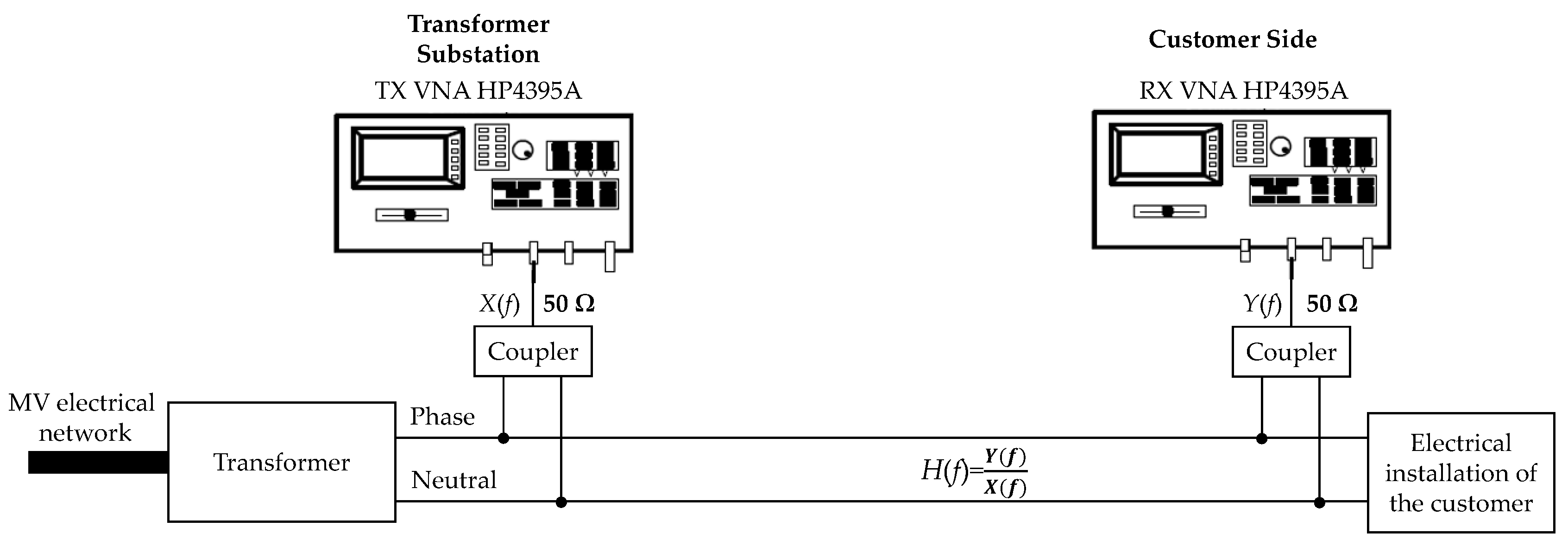
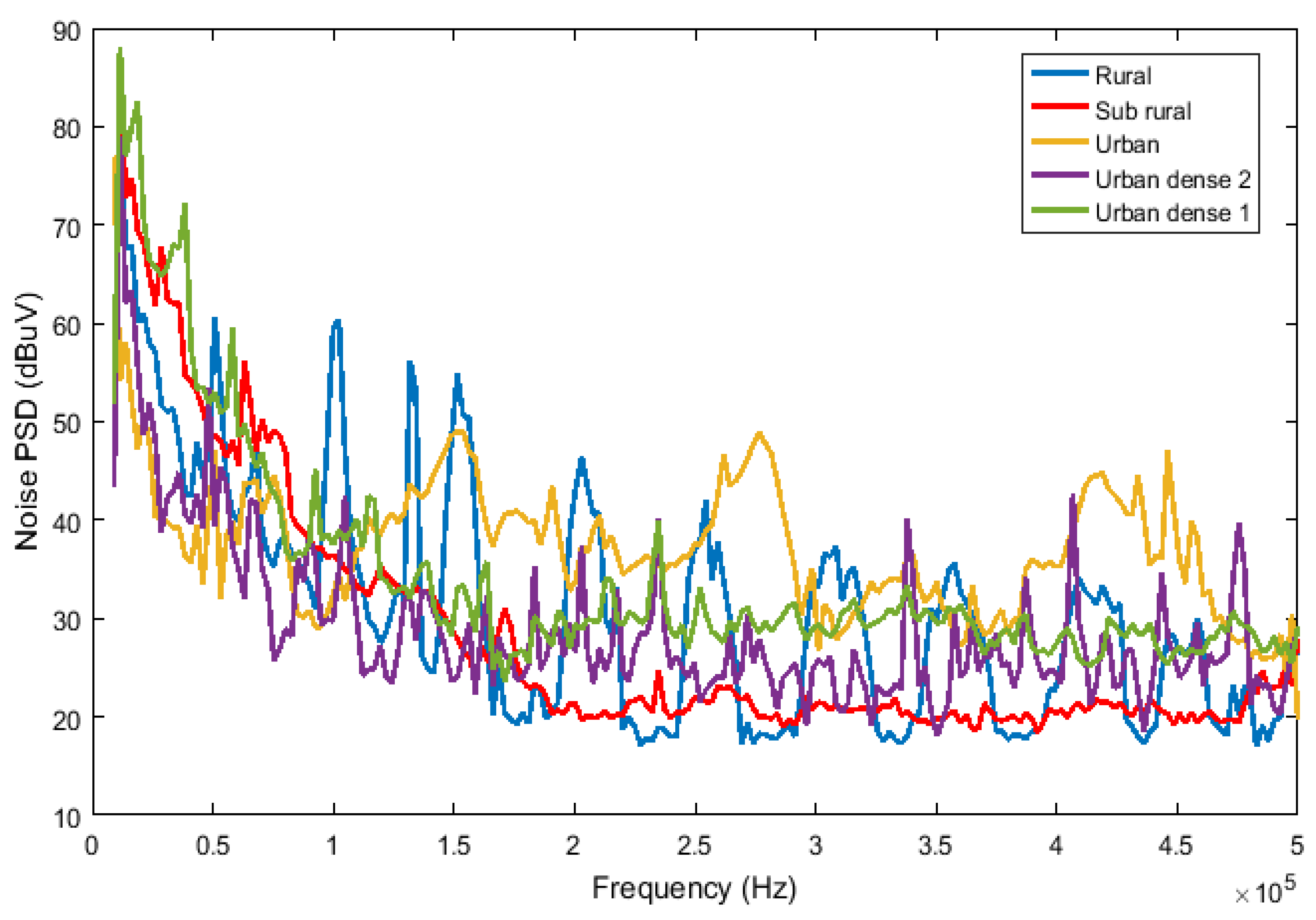
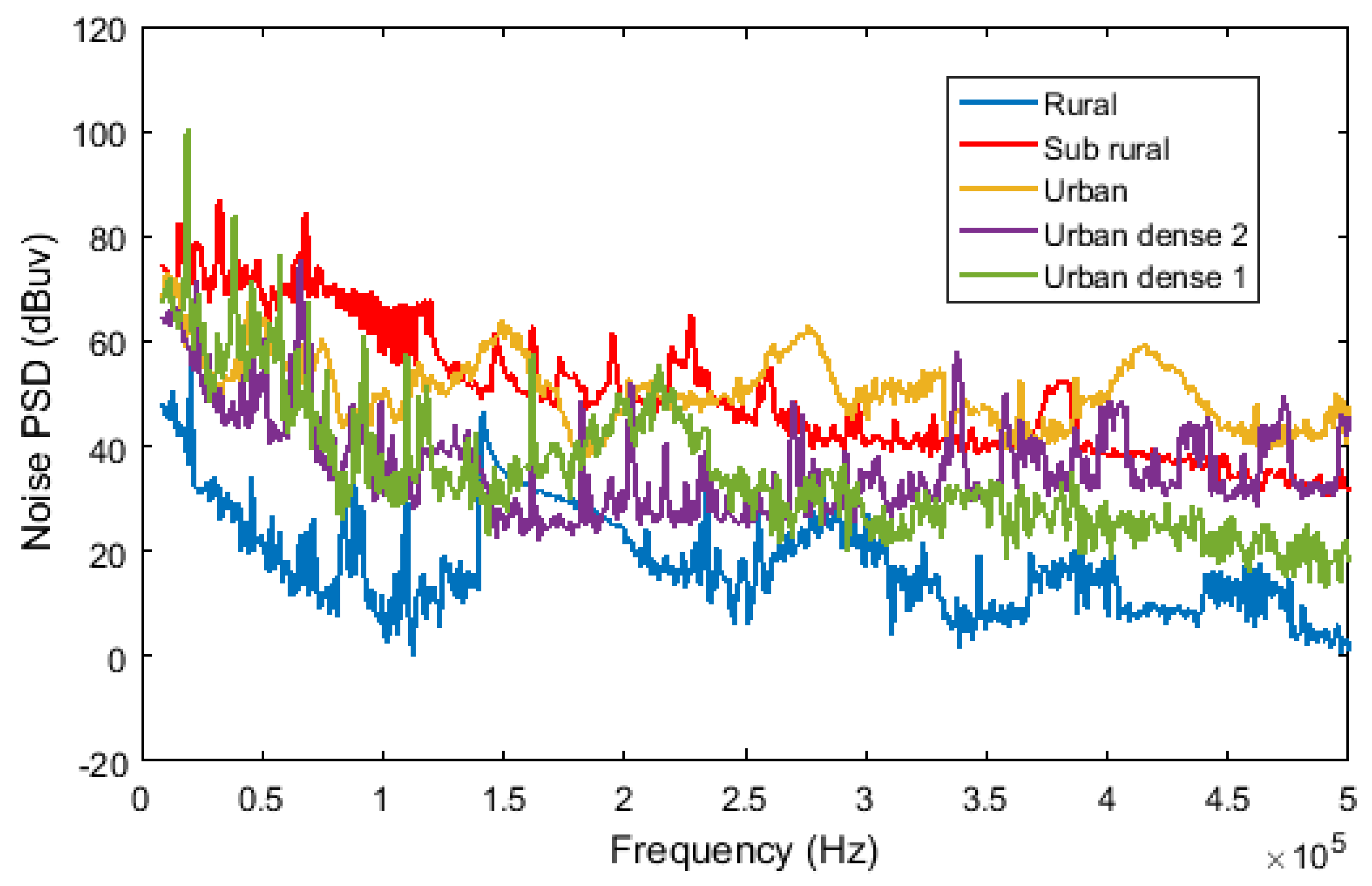
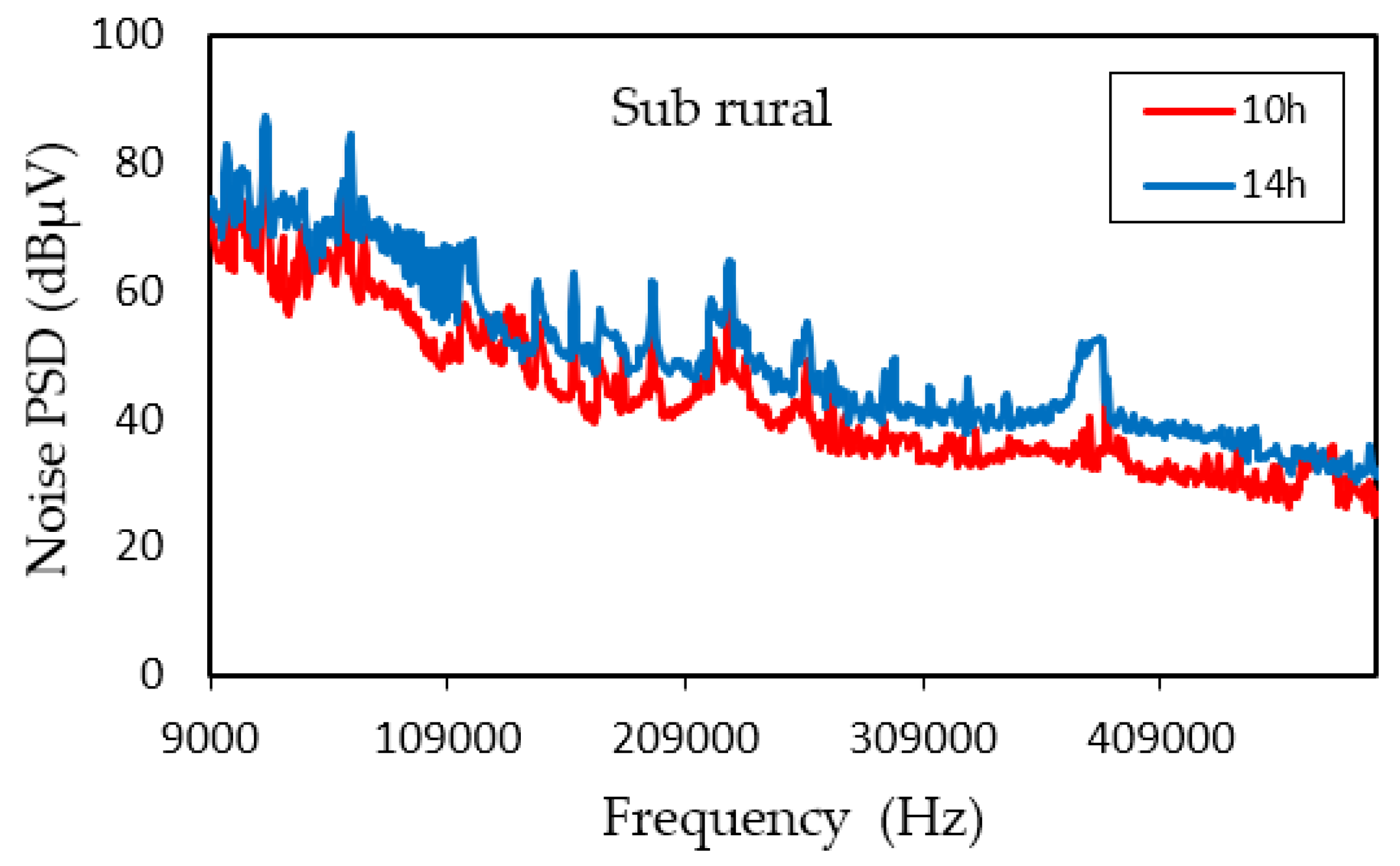

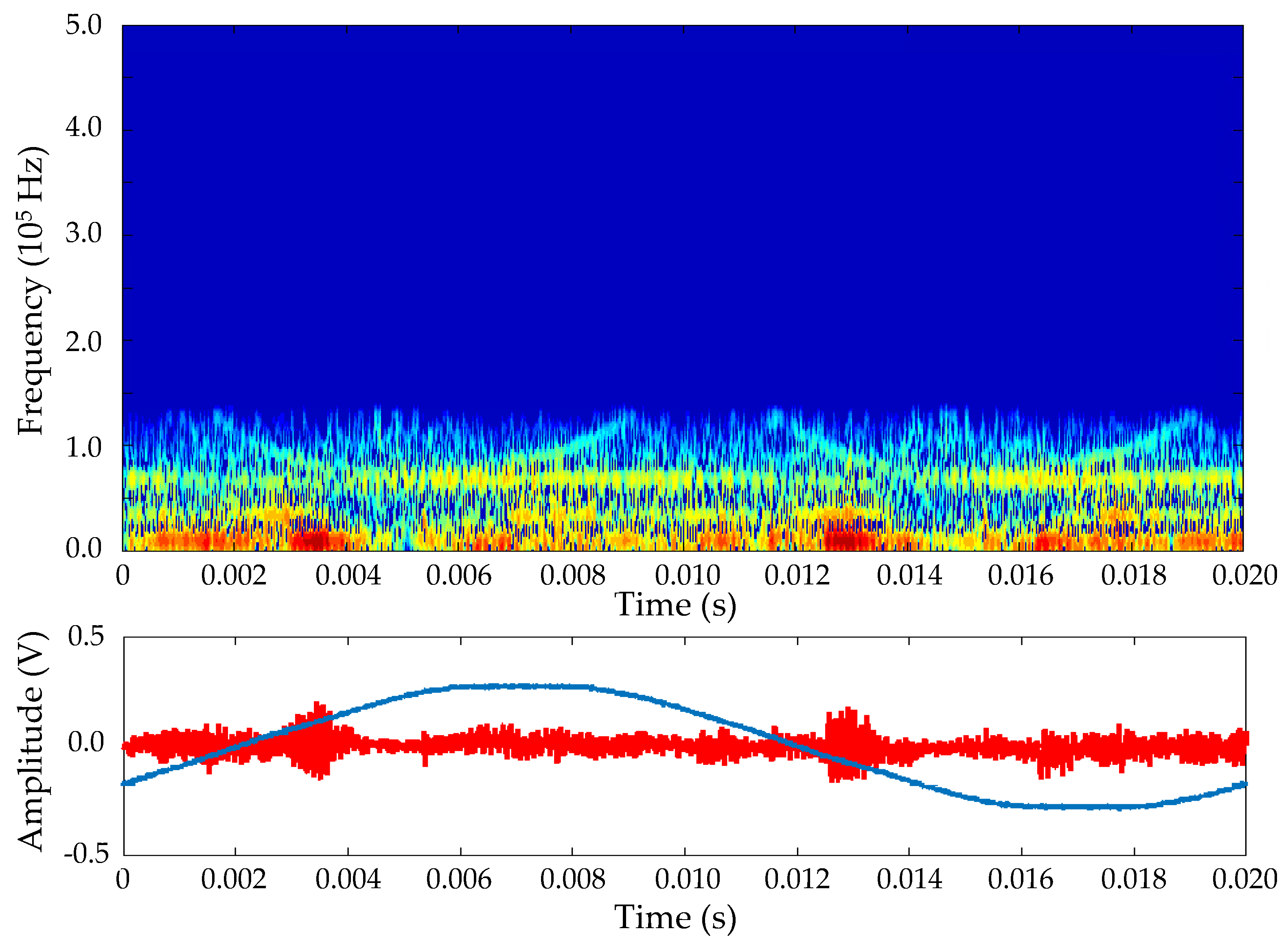
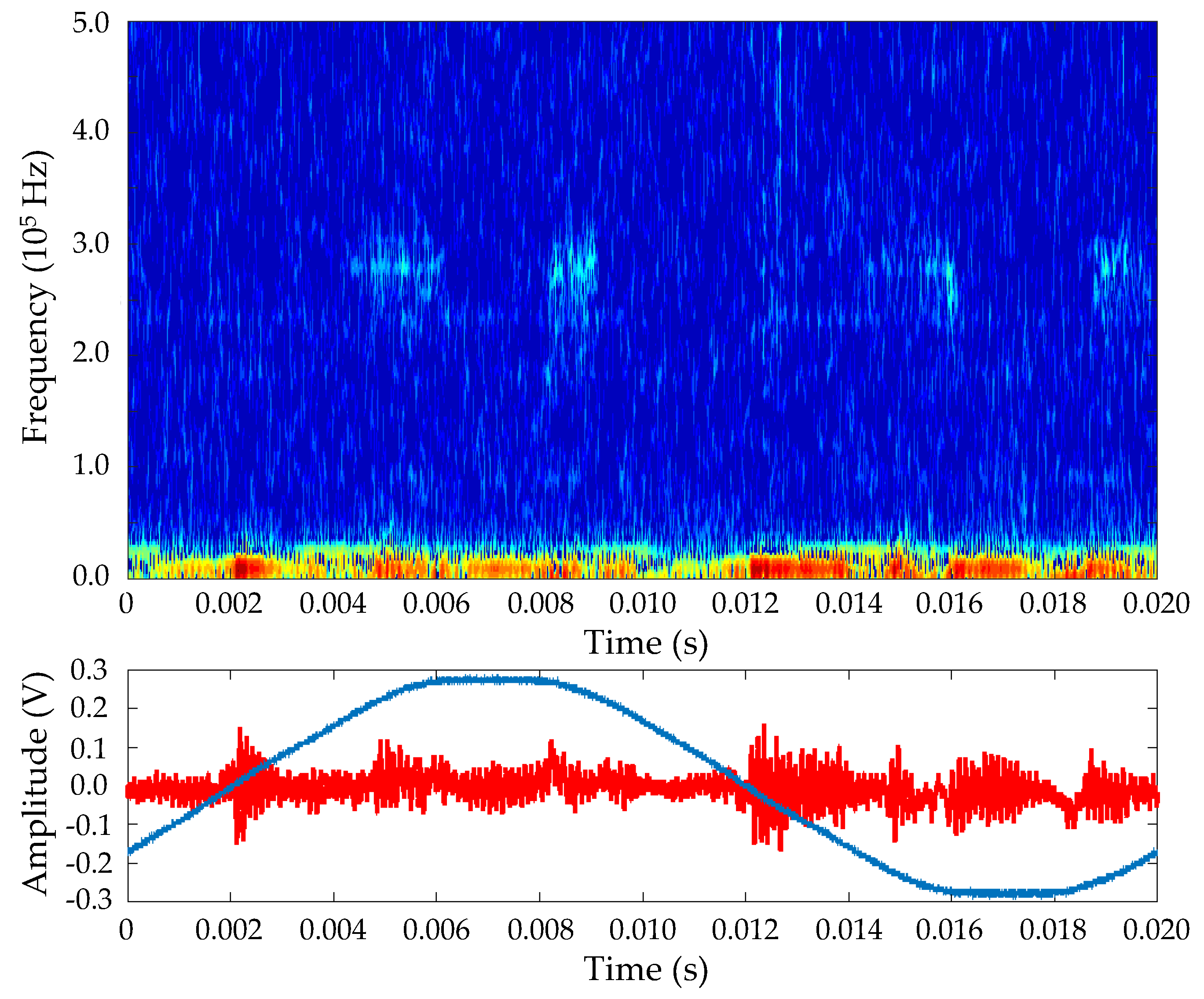
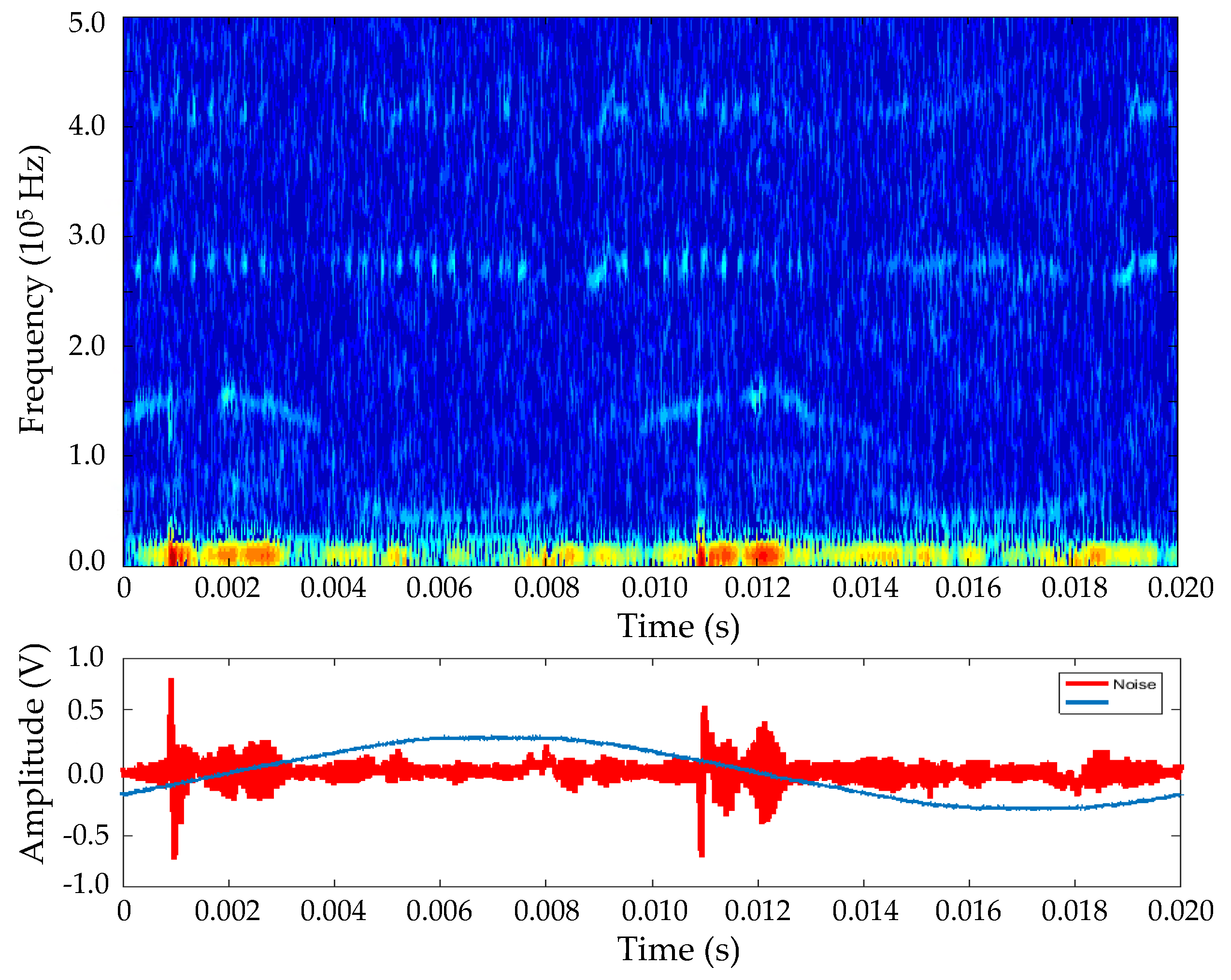

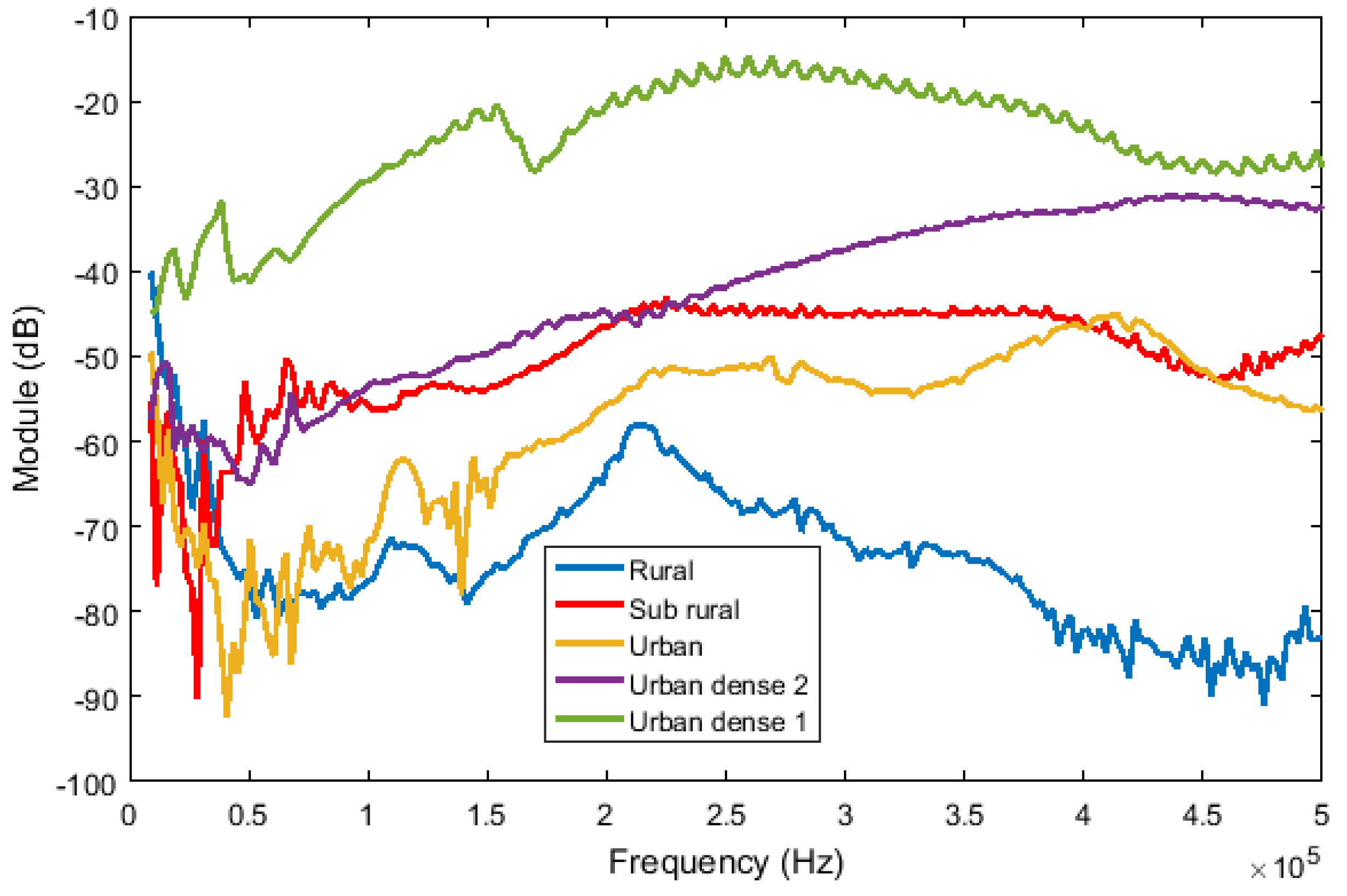
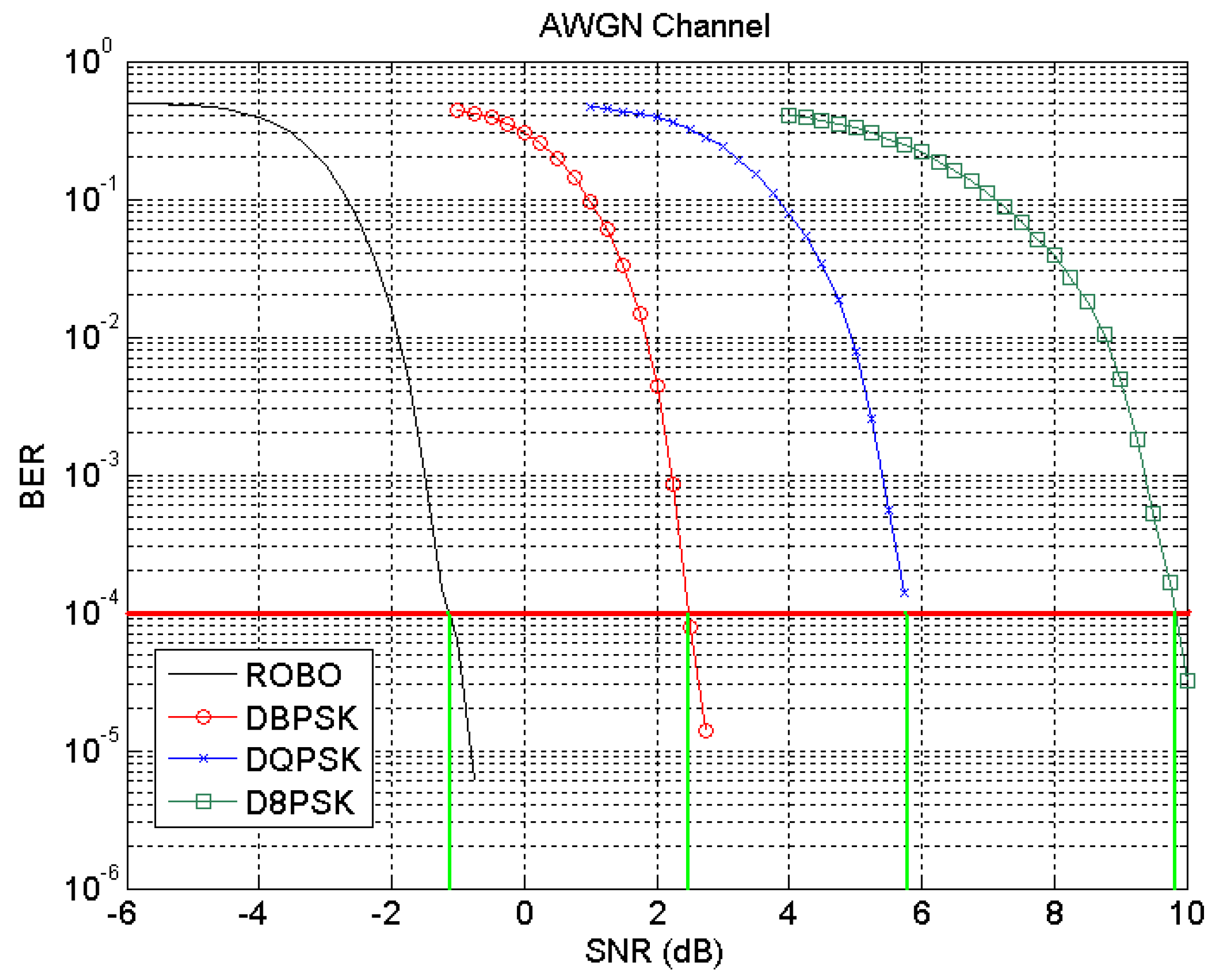
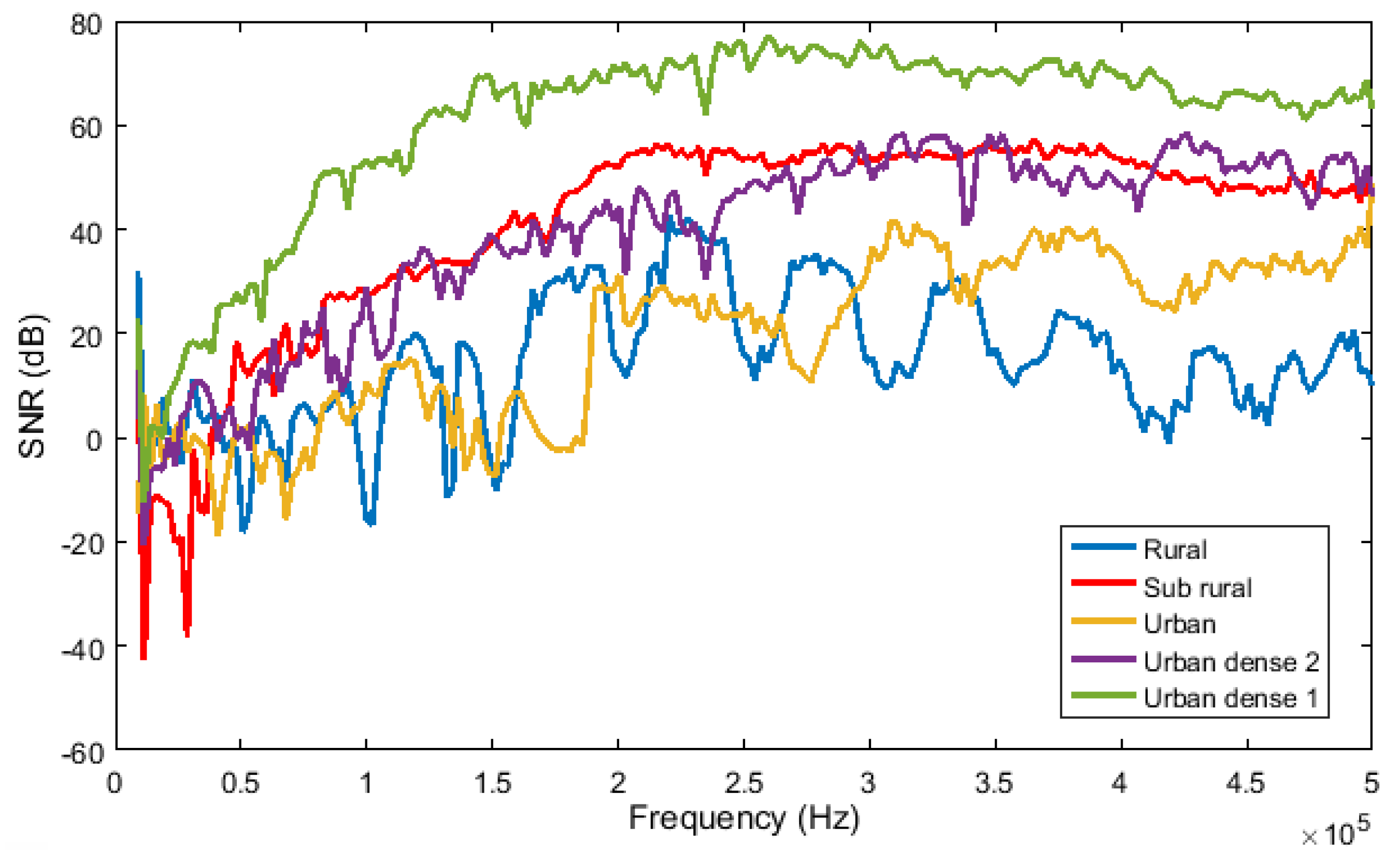
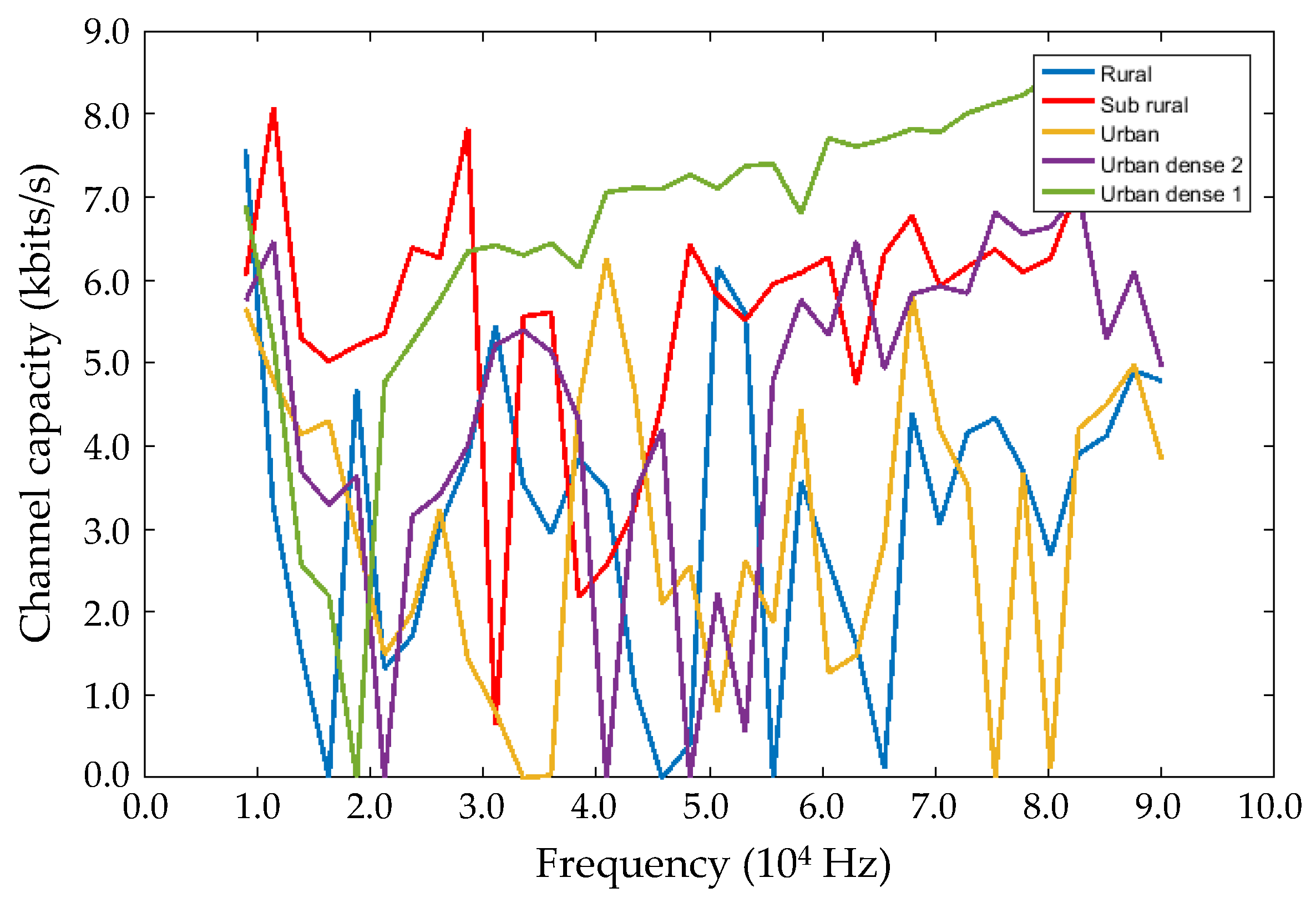
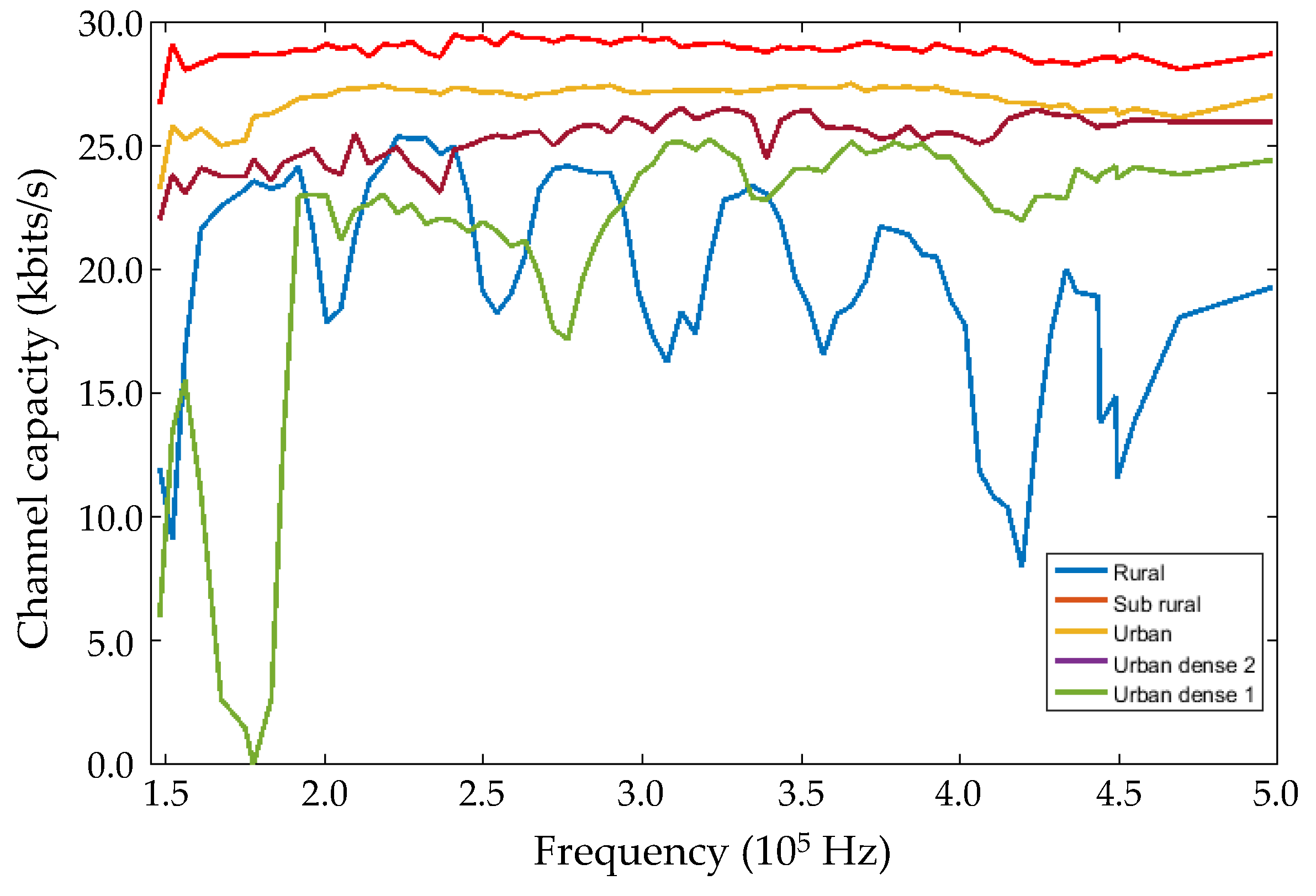
| Modulations | G1 (S-FSK) | G3 (D8PSK) | G3 (DQPSQ) | G3 (DBPSK) | G3 (Robo) |
|---|---|---|---|---|---|
| SNR (TEB: ) | 12 dB | 9.6 dB | 5.6 dB | 2.5 dB | −1.2 dB |
| Mean Channel Capacity | Urban Dense 1 | Urban Dense 2 | Sub Rural | Rural | Urban |
|---|---|---|---|---|---|
| CENELEC A (kbits/s) | 238 | 170 | 216 | 102 | 136 |
| FCC (Mbits/s) | 1.58 | 1.73 | 2.21 | 1.31 | 1.92 |
| Type of Noise | Main Characteristics | Urban Dense 1 | Sub Rural | Rural | Urban |
|---|---|---|---|---|---|
| Stationary | Magnitude | 50 mV | 50 mV | 50 mV | 100 mV |
| Periodic impulsive | Magnitude | 100 mV | 50 mV | 200 mV | 700 mV |
| Cycle time | 10 ms | 10 ms | 10 ms | 10 ms | |
| Duration | 3 ms | 2 ms | 2 ms | 1 ms | |
| Aperiodic impulsive | Magnitude | >1 V | >500 mV | >2 V | >400 mV |
| Duration | 1 ms | 2 ms | 2 ms | 2 ms |
© 2018 by the authors. Licensee MDPI, Basel, Switzerland. This article is an open access article distributed under the terms and conditions of the Creative Commons Attribution (CC BY) license (http://creativecommons.org/licenses/by/4.0/).
Share and Cite
Elfeki, I.; Jacques, S.; Aouichak, I.; Doligez, T.; Raingeaud, Y.; Le Bunetel, J.-C. Characterization of Narrowband Noise and Channel Capacity for Powerline Communication in France. Energies 2018, 11, 3022. https://doi.org/10.3390/en11113022
Elfeki I, Jacques S, Aouichak I, Doligez T, Raingeaud Y, Le Bunetel J-C. Characterization of Narrowband Noise and Channel Capacity for Powerline Communication in France. Energies. 2018; 11(11):3022. https://doi.org/10.3390/en11113022
Chicago/Turabian StyleElfeki, Imène, Sébastien Jacques, Ismail Aouichak, Thierry Doligez, Yves Raingeaud, and Jean-Charles Le Bunetel. 2018. "Characterization of Narrowband Noise and Channel Capacity for Powerline Communication in France" Energies 11, no. 11: 3022. https://doi.org/10.3390/en11113022






